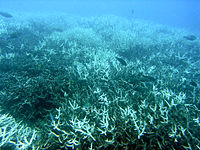
Photo from wikipedia
Following disturbances, corals recolonize space through the process of recruitment consisting of the three phases of propagule supply, settlement, and post-settlement survival. Yet, each phase is influenced by biophysical factors,… Click to show full abstract
Following disturbances, corals recolonize space through the process of recruitment consisting of the three phases of propagule supply, settlement, and post-settlement survival. Yet, each phase is influenced by biophysical factors, leading to recruitment success variability through space. To resolve the relative contributions of biophysical factors on coral recruitment, the recovery of a 150 km long coral reefs in Palau was investigated after severe typhoon disturbances. Overall, we found that benthic organisms had a relatively weak interactive influence on larval settlement rates at the scale of individual tiles, with negative effects mainly exerted from high wave exposure for Acropora corals. In contrast, juvenile coral densities were well predicted by biophysical drivers, through both direct and indirect pathways. High densities of Acropora and Poritidae juveniles were directly explained by the availability of substrata free from space competitors. Juvenile Montipora were found in higher densities where coralline algae coverage was high, which occurred at reefs with high wave exposure, while high densities of juvenile Pocilloporidae occurred on structurally complex reefs with high biomass of bioeroder fish. Our findings demonstrate that strengths of biophysical interactions were taxon-specific and had cascading effects on coral recruitment, which need consideration for predicting reef recovery and conservation strategies.
Journal Title: Scientific Reports
Year Published: 2020
Link to full text (if available)
Share on Social Media: Sign Up to like & get
recommendations!